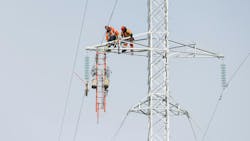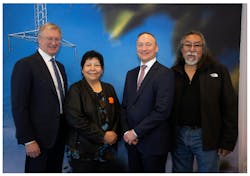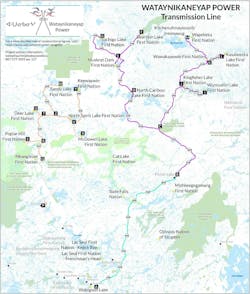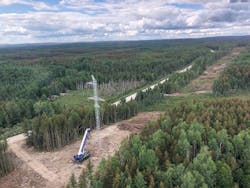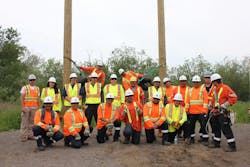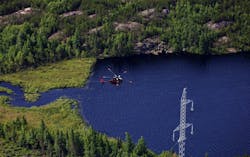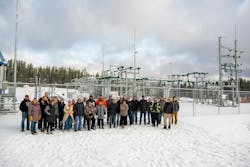The ‘Line that Brings Light’ to 17 First Nations in Northern Canada
Key Highlights
- The project connects 17 First Nations in northwestern Ontario to the Ontario power grid, replacing costly and unreliable diesel generators.
- Owned 51% by First Nations, with plans for full ownership after 25 years, it represents a groundbreaking model of Indigenous infrastructure empowerment.
- Construction involved 1,800 km of transmission lines, 22 substations, and extensive community engagement, including over 3,000 consultations and training programs.
- The initiative was guided by strong governance, respecting land rights and ensuring First Nations decision-making authority throughout the project.
- Despite challenges like remote terrain and the COVID-19 pandemic, the project was completed on schedule, delivering immediate benefits such as new homes, schools, and community facilities.
The Wataynikaneyap Power Transmission System has transformed electricity delivery for 17 First Nations in northwestern Ontario, Canada. For years, these remote communities relied on diesel generators, but this $1.9 billion CAD project, whose name means “line that brings light” in Anishininiimowin, has greatly improved energy access. Owned jointly by 24 First Nations (51%) in partnership with Fortis Inc. and other private investors, the project underscores the power of partnership and shared vision in achieving sustainable energy solutions.
The project encompasses 1,800 kilometers (1118.5 miles) of transmission lines and 22 substations, connecting remote First Nations to the Ontario provincial power grid. Construction began in 2020 and was completed in May 2024. This extensive network enhances energy reliability for communities that faced the challenges of managing diesel –generated power.
An Innovative Partnership
At the heart of the Wataynikaneyap Power Transmission Project is the success of 24 First Nations working together, and a strong connection between the First Nation partnership and Fortis. The partnership exemplifies how teamwork can overcome hurdles in the delivery of safe, reliable and clean energy.
Fortis, a diversified leader in the North American regulated electricity and gas industry with headquarters in St. John’s, Newfoundland and Labrador, was selected as partner and project manager in 2015 over six other bidders because it shared the First Nation’s vision to maintain majority ownership. After 25 years, the First Nations will own 100% of the transmission system, creating an unprecedented model of Indigenous ownership in Canadian infrastructure and empowerment.
As Margaret Kenequanash, CEO of Wataynikaneyap Power, reflects, “Owning infrastructure in our Homelands and building a solid foundation for future generations has been a success. This accomplishment is based on the collective vision and direction of all the 24 First Nations working together and supported by our partner Fortis.”
The Urgent Need
The motivation behind this project has deep roots, tracing back over 35 years, with dedicated First Nations leadership and many others at the forefront, navigated by Kenequanash. Until now, the 17 remote First Nations were not connected to the Ontario provincial power grid. Over 20,000 residents relied on unreliable and costly diesel-powered electricity — transported only during winter on ice roads or at expensive airlift costs — resulting in challenges for community life.
Diesel generators often operated at maximum capacity, resulting in load restrictions and leading to power outages, school closures, and food spoilage. First Nations were unable to connect new homes to power or increase existing services due to power being at capacity. The financial burden was significant, with Ontario’s Independent Electricity System Operator (IESO) estimating diesel costs at around $90 million annually.
Governance, Leadership and Engagement
Completing this complex transmission mega project required immense leadership. The project was guided by an effective governance framework that ensured strategic direction and equal First Nations partnership with one voice. The principles established essential expectations for respecting First Nation lands and rights and ensured First Nations retained decision-making authority.
Wataynikaneyap Power, a licensed transmission company established for the project, is governed by a board of directors that includes two Fortis representatives, two First Nation partnership representatives, and an elder advisor. The board chair and CEO are both First Nation representatives, and the COO and CFO are from Fortis.
Fortis, with over 140 years of utility operations experience, drew on industry veterans and experts from its companies, including ITC Holdings Corp — a large, independent electricity transmission company in the U.S. — to lead project management.
Fortis managed the construction of the project through Wataynikaneyap Power Project Management Inc. This team is responsible for everything from regulatory compliance, engineering, construction management and operations.
First Nations chiefs, elders, and tribal councils provided tremendous guidance and leadership and a solid foundation rooted in their culture, language and way of life. They effectively represented their communities to realize their vision of clean, reliable power and maintain infrastructure ownership.
Utility contractor Valard Construction, a Quanta Services company, was the engineering, procurement and construction (EPC) contractor. Hatch, a global engineering and project management firm, was the owner’s engineer, while Mott MacDonald provided independent engineering oversight services.
Extensive engagement with First Nations officials was conducted — without their consent, the project could not have proceeded. A community liaison was established for each of the First Nations communities. Regular meetings, engagement and transparent communication channels were established to address concerns, share updates and gather feedback. Much of the community engagement and preparedness was facilitated through Opiikapawiin Services LP (OSLP), owned entirely by the 24 First Nations. Fifty-five training programs and nearly 3,000 engagements with leaders, community members and elders were conducted. Effective communication was also a cornerstone of the project. All newsletters and bulletins were translated into Anishininiimowin to ensure that information was accessible.
Project funding was secured through a multifaceted framework involving financial support from the Canadian and Ontario governments, First Nations, Fortis and participation from five of Canada’s major banks.
Constructing the System
To connect the 17 remote communities to the Ontario electrical grid, Wataynikaneyap Power had to conceptualize, design, and build a complete energy network, including 22 substations and an 1,800-kilometer transmission line comprised primarily of 230 kV and 115 kV lines.
The vast remoteness and size of the project footprint intensified the planning, engagement, communication, and ingenuity required to make this project a reality.
The energy network covers a large landmass nearly the size of Germany. Sixteen of the 22 substations and half of the transmission line were only accessible during winter. This meant nearly a year’s work had to be compressed into just three months when winter roads and ice roads were established. The project’s workforce increased from a couple of hundred employees to 1400 during the winter months, during which they worked in challenging weather conditions. Winter was also critical for materials planning, as anything needed for the upcoming construction season had to be transported a year in advance.
The project required meticulous planning and coordination, leading to comprehensive technical specifications for design, materials, and construction methods. Customized document management tools provided near real-time access throughout the process, while extensive geotechnical work ensured optimal structure design and placement.
Originally designed with wooden structures, the project shifted to steel towers. Although typically more expensive, declines in global steel prices and the benefits of installing in challenging northern terrain made this option more cost-effective. This change, advocated for by the First Nations, enhanced fire and weather protection, reduced environmental impact, and increased job opportunities.
Materials were procured globally, adhering to special reliability standards for a remote transmission line in Northern Canada. Over 90,000 helicopter hours were logged for tower erection, insulator hanging, transmission line stringing and transport. Extensive matting minimized the ground footprint, and the work schedule aligned with First Nations’ land use guidelines, safeguarding the environment and wildlife.
The leadership and expertise required for project success were evident throughout construction. One notable example was the COVID-19 pandemic. Two months after construction began in January 2020, the World Health Organization declared the pandemic.
The risks were significant, as workers across North America traveled to First Nations communities with limited medical resources. Facing the threat of a shutdown, the Project leadership teams quickly worked together with public health officials, the First Nations, and partners to develop a comprehensive COVID-19 management plan.
The health risks to the communities were very real, but so, too, was the risk of stopping the project. Delivering reliable power to the communities was crucial. Ultimately, the project was classified as an essential service and was granted permission to proceed.
Advancing Electricity for First Nations
The Wataynikaneyap Power Transmission System is creating sustainable, long-term opportunities with clean, reliable power already transforming lives.
New homes, schools, health facilities and fitness centers have been established. Kasabonika Lake First Nation added floodlights to its sports field, allowing recreational sports to continue into the evening, while Pikangikum First Nation enjoyed Christmas lights for the first time in over a decade.
The project is one of the most impactful projects Fortis has ever been involved in.
“The successful completion of this project is a testament to our commitment to our First Nations partners and their unwavering dedication to turning this vision into reality. Access to clean, reliable, and abundant energy will empower First Nations and pave the way for a brighter, more sustainable future for generations to come. Seeing the immediate and profound impact of the Wataynikaneyap Power Transmission Project on the communities it serves has been truly humbling,” said David Hutchens, president and CEO of Fortis Inc.
The Wataynikaneyap Power Transmission System is a powerful example of how public-private partnerships can enhance access to clean and reliable energy, especially in the face of growing global electricity demands. This Indigenous-led initiative illustrates a hopeful path forward for energy innovation, paving the way for a brighter, more equitable future for all.
About the Author
Gary Smith
Gary Smith - Executive Vice President, Operations and Technology, Fortis Inc.
With four decades of experience in the energy sector, Gary Smith currently serves as the Executive Vice President of Operations and Technology at Fortis Inc. He oversees operations spanning $73 billion in assets and 9,800 employees, ensuring safety, reliability, and cybersecurity across Fortis’ regulated utilities in Canada, the U.S. and the Caribbean.
Karyn Whelan
Karyn Whelan – Corporate Communications Advisor, Fortis Inc.
Karyn Whelan is the Corporate Communications Advisor at Fortis Inc., where she supports both internal and external communications. She is a certified Strategic Communications Management Professional (SCMP).
